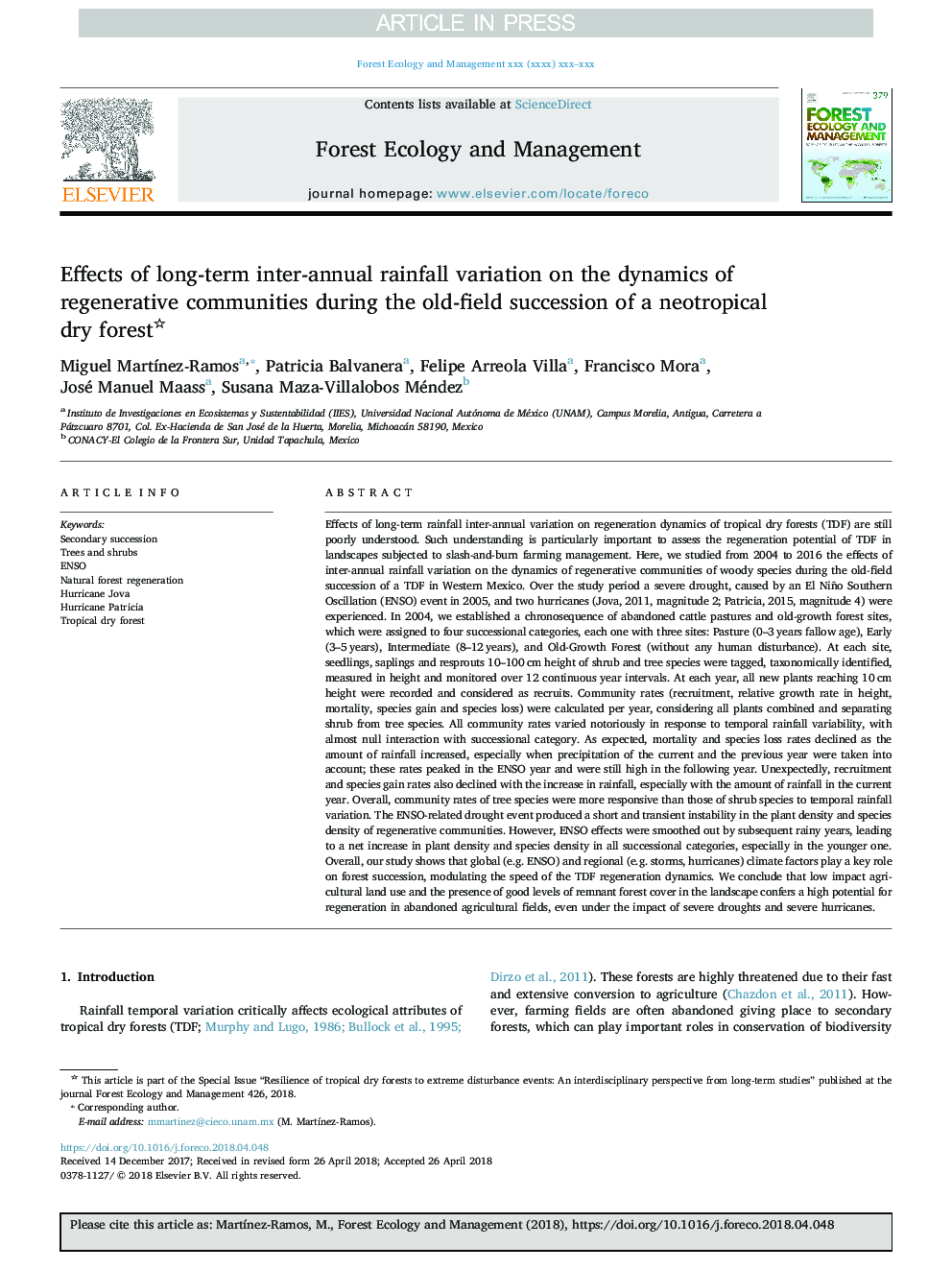| کد مقاله | کد نشریه | سال انتشار | مقاله انگلیسی | نسخه تمام متن |
|---|---|---|---|---|
| 6541546 | 1421334 | 2018 | 10 صفحه PDF | دانلود رایگان |
عنوان انگلیسی مقاله ISI
Effects of long-term inter-annual rainfall variation on the dynamics of regenerative communities during the old-field succession of a neotropical dry forest
ترجمه فارسی عنوان
اثرات تنش های بارندگی بلندمدت بین سالیانه بر پویایی جوامع بازتوزیع شده در طول جنگل های قدیمی جنگل های خشخاش نئوتروپیک
دانلود مقاله + سفارش ترجمه
دانلود مقاله ISI انگلیسی
رایگان برای ایرانیان
موضوعات مرتبط
علوم زیستی و بیوفناوری
علوم کشاورزی و بیولوژیک
بوم شناسی، تکامل، رفتار و سامانه شناسی
چکیده انگلیسی
Effects of long-term rainfall inter-annual variation on regeneration dynamics of tropical dry forests (TDF) are still poorly understood. Such understanding is particularly important to assess the regeneration potential of TDF in landscapes subjected to slash-and-burn farming management. Here, we studied from 2004 to 2016 the effects of inter-annual rainfall variation on the dynamics of regenerative communities of woody species during the old-field succession of a TDF in Western Mexico. Over the study period a severe drought, caused by an El Niño Southern Oscillation (ENSO) event in 2005, and two hurricanes (Jova, 2011, magnitude 2; Patricia, 2015, magnitude 4) were experienced. In 2004, we established a chronosequence of abandoned cattle pastures and old-growth forest sites, which were assigned to four successional categories, each one with three sites: Pasture (0-3â¯years fallow age), Early (3-5â¯years), Intermediate (8-12â¯years), and Old-Growth Forest (without any human disturbance). At each site, seedlings, saplings and resprouts 10-100â¯cm height of shrub and tree species were tagged, taxonomically identified, measured in height and monitored over 12 continuous year intervals. At each year, all new plants reaching 10â¯cm height were recorded and considered as recruits. Community rates (recruitment, relative growth rate in height, mortality, species gain and species loss) were calculated per year, considering all plants combined and separating shrub from tree species. All community rates varied notoriously in response to temporal rainfall variability, with almost null interaction with successional category. As expected, mortality and species loss rates declined as the amount of rainfall increased, especially when precipitation of the current and the previous year were taken into account; these rates peaked in the ENSO year and were still high in the following year. Unexpectedly, recruitment and species gain rates also declined with the increase in rainfall, especially with the amount of rainfall in the current year. Overall, community rates of tree species were more responsive than those of shrub species to temporal rainfall variation. The ENSO-related drought event produced a short and transient instability in the plant density and species density of regenerative communities. However, ENSO effects were smoothed out by subsequent rainy years, leading to a net increase in plant density and species density in all successional categories, especially in the younger one. Overall, our study shows that global (e.g. ENSO) and regional (e.g. storms, hurricanes) climate factors play a key role on forest succession, modulating the speed of the TDF regeneration dynamics. We conclude that low impact agricultural land use and the presence of good levels of remnant forest cover in the landscape confers a high potential for regeneration in abandoned agricultural fields, even under the impact of severe droughts and severe hurricanes.
ناشر
Database: Elsevier - ScienceDirect (ساینس دایرکت)
Journal: Forest Ecology and Management - Volume 426, 15 October 2018, Pages 91-100
Journal: Forest Ecology and Management - Volume 426, 15 October 2018, Pages 91-100
نویسندگان
Miguel MartÃnez-Ramos, Patricia Balvanera, Felipe Arreola Villa, Francisco Mora, José Manuel Maass, Susana Maza-Villalobos Méndez,
